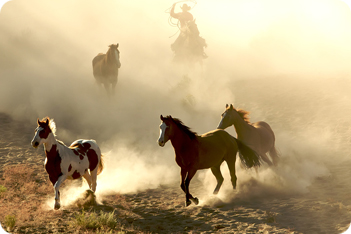

Equine Muscles
There are three types of muscle within the equine skeleton and they are smooth muscles, cardiac muscle and skeletal muscles.
Muscle Types
- Skeletal muscles are made up of muscle fibres which use contraction to initiate movement. As one muscle contracts so another extends allowing movement to take place. These muscle fibres can be slow twitch or fast twitch. Slow-twitch or type 1 fibres contract slowly for a long time and are found in high numbers in endurance horses. Fast-twitch or type 2 fibres have more powerful contractions but tire more easily and are seen more in power sports such as dressage and show jumpers. Muscles are attached to bone via tendons.
- Smooth muscles have involuntary contractions and are found in the digestive processes of the horse.
- Cardiac muscles have involuntary contractions and are made up of fibres only found in the heart. As the cardiac muscles contract blood is able to enter the heart.
The Main Skeletal Muscles
- Masseter - Used for opening and closing the jaw.
- Brachiocephalicus - Used for both head movement and for moving the shoulder and lifting the scapula.
- Sternocephalic - Used for head and neck movement
- Rhomboidus - Used for moving the scapula and therefore the shoulder.
- Splenius - Allows neck mobility.
- Trapezius - Allows the shoulder and foreleg to lift.
Skeletal Muscles Continued;
- Deltoid - Allows shoulder movement.
- Supraspinusatus - Used for extending the shoulder.
- Latissimus dorsi - Supports the back and allows the shoulder to flex.
- Triceps - Used to allow shoulder to flex and to allow the elbow to extend outwards.
- Biceps - Used to allow the elbow to flex and to allow the shoulder to extend.
- Pectoral - Used to allow foreleg movement.
- Extensor Carpus - Allows the knee to extend.
- Flexor Carpus - Allows knee mobility.
- Digital Extensor - Allows the knee to extend.
- Digital flexor - Allows the knee and elbow to flex.
- Longissimus dorsi - These lumbar muscles support and flex the head, neck and spine.
- Intercostal muscles - Allow movement of the ribs to take place.
- Abdominal muscles - Provides support to the internal organs.
- Superficial gluteal - Allows flexion and extension of the hindleg to take place
- Biceps femoris - Used for hip and hindleg movement.
- Semitendinosis - Used for moving the hip and hock joint.
- Semi membranous - Allows hindleg movement.
- Gastrocnemius - Allows hip extension to take place.